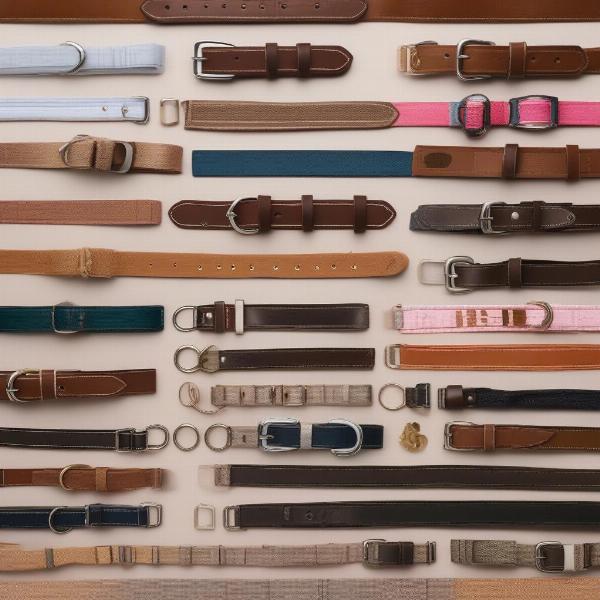Choosing the right collar for your small dog puppy is an important decision. It’s their first introduction to canine accessories and plays a vital role in their safety, training, and overall well-being. This guide will walk you through everything you need to know about puppy collars for small dogs, from selecting the right size and material to introducing it properly.
Choosing the Right Type of Puppy Collar
Several collar types are available, each with its benefits and drawbacks. For small breed puppies, certain collars are better suited than others.
Flat Collars: The Classic Choice
Flat collars are the most common type, typically made of nylon, leather, or fabric. They’re excellent for everyday wear, attaching ID tags, and basic leash training. For small breeds, choose a lightweight and narrow flat collar to avoid unnecessary strain on their delicate necks.
Harnesses: Added Comfort and Control
Harnesses distribute pressure across the chest and back, reducing strain on the neck. They’re especially beneficial for small breeds prone to tracheal collapse. Puppies who pull excessively can also benefit from the added control a harness offers.
Breakaway Collars: Prioritizing Safety
Breakaway collars feature a safety release mechanism that opens under pressure, preventing choking hazards if your puppy gets caught on something. They’re a great option for playful puppies who love to explore. However, they may not be suitable for off-leash activities.
Sizing and Fitting Your Puppy’s Collar
A properly fitted collar is crucial for both comfort and safety. It should be snug enough to prevent slipping over the head but loose enough to allow two fingers to fit comfortably between the collar and your puppy’s neck.
Measuring Your Puppy’s Neck
Use a soft measuring tape to determine the circumference of your puppy’s neck. Add two inches to this measurement to get the ideal collar size.
Materials and Considerations
Puppy collars are made from various materials, each with its unique characteristics:
- Nylon: Durable, waterproof, and easy to clean.
- Leather: Stylish and comfortable, but requires more care.
- Fabric: Soft and often patterned, ideal for sensitive skin.
 Various puppy collars in different materials and styles
Various puppy collars in different materials and styles
Introducing the Collar to Your Puppy
Introduce the collar gradually and positively. Start with short periods of wear, associating it with positive experiences like treats and playtime. This will help your puppy accept the collar without fear or anxiety.
Training Collar for Small Dogs: A Separate Consideration
While a standard puppy collar is suitable for everyday wear and basic leash training, a training collar for small dogs might be necessary for addressing specific behavioral issues. These collars should be used under the guidance of a professional dog trainer.
Choosing a Tiny Dog Collar: Key Factors
When selecting a tiny dog collar, consider the weight and fragility of your small breed. Look for lightweight materials and delicate hardware that won’t weigh your puppy down.
Extra Small Dog Collars: Finding the Perfect Fit
Finding extra small dog collars can sometimes be challenging. Look for brands specializing in miniature breeds or adjustable collars with a wide size range.
Conclusion
Selecting the appropriate puppy collar for your small dog is an essential step in responsible pet ownership. By considering the factors outlined in this guide, you can ensure your puppy’s comfort, safety, and well-being while providing them with a stylish and functional accessory. Remember, a well-fitted collar is the foundation for a positive training experience and a strong bond between you and your furry friend.
FAQ
-
How tight should a puppy collar be? You should be able to fit two fingers comfortably between the collar and your puppy’s neck.
-
What’s the best material for a puppy collar? Nylon is a popular choice for its durability and ease of cleaning, but leather and fabric are also good options depending on your puppy’s needs.
-
When can I start using a collar on my puppy? You can introduce a collar as early as a few weeks old, starting with short periods and positive reinforcement.
-
Are harnesses better than collars for small dogs? Harnesses can be a good option for small breeds prone to tracheal collapse or those who pull excessively on the leash.
-
What is a breakaway collar? A breakaway collar has a safety mechanism that releases under pressure, preventing choking if the collar gets caught.
-
What should I look for in a collar for a tiny dog? Choose a lightweight collar with delicate hardware to avoid putting unnecessary strain on your tiny dog’s neck.
-
Where can I find extra small dog collars? Look for brands specializing in miniature breeds or adjustable collars with a wide size range.
Finding the Right Barking Dog Collar for Small Dogs
If excessive barking is a concern, a barking dog collars for small dogs might be a helpful tool. However, it’s crucial to choose a humane option and consult with a professional trainer before using one.
Add a Touch of Style with a Sunflower Dog Collar
Beyond functionality, you can also express your puppy’s personality with a stylish collar. A sunflower dog collar is a cheerful and trendy choice that will make your puppy stand out.
About ILM Dog
ILM Dog is your one-stop resource for expert advice on dog breeds, health, training, nutrition, grooming, and much more. We’re dedicated to providing dog owners worldwide with reliable, practical information to help them provide the best possible care for their canine companions. Whether you’re a seasoned dog owner or just starting your journey, ILM Dog is here to support you every step of the way. Contact us today for expert advice and personalized support! Email: [email protected], Phone: +44 20-3965-8624.